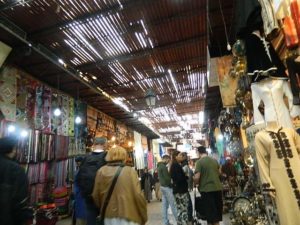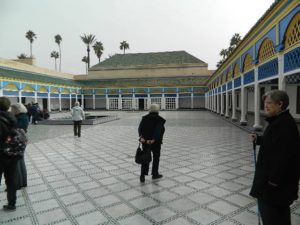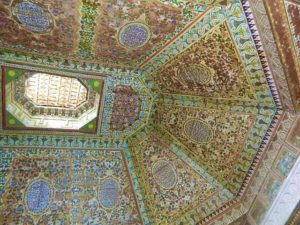They call it the Red City — but the plaster that covers many of its buildings is closer to a deep coral. Stunning. It’s become a winter playground for Europeans with the development of modern apartment buildings and hotels like the one we stayed in. We’re surprised when we look out our window and see a lineup of some of the gaudy, but dusty, road  racing Fiat 500s that scooted by us as we crossed the desert.
racing Fiat 500s that scooted by us as we crossed the desert.
It’s quite a walk, or a fair taxi ride, to the old city, to the medina surrounded by 19km of ramparts built a thousand years ago, its wealth accumulated from centuries of trade in slaves, gold, sugar, ivory and leather. Today its  people-packed souk is a labyrinth of shops selling crafts of every quality and just about everything else. We’re totally lost, but wandering is the point.
people-packed souk is a labyrinth of shops selling crafts of every quality and just about everything else. We’re totally lost, but wandering is the point.
Eventually we emerge into the city’s enormous main square — the Djemaa El-Fna. A thousand years ago it was the site of public executions. Its name means Assembly of the Dead. These days it hosts a living theater of oboe playing snake charmers, jugglers, henna tattoo artists, musicians, and the 100 chefs who descend on the square at dusk to set up their tents and grills. It’s a UNESCO World Heritage site.
Parts of the Bahia Palace’s 150 rooms are open to the public. We enter  the courtyard of the harem off of which each of Vizier Abu Ahmed’s four wives and 24 concubines had their quarters. Carved atlas cedar on the exterior and intricate plaster and tile and stained glass and silk wall hangings inside. Ceilings a specialty.
the courtyard of the harem off of which each of Vizier Abu Ahmed’s four wives and 24 concubines had their quarters. Carved atlas cedar on the exterior and intricate plaster and tile and stained glass and silk wall hangings inside. Ceilings a specialty.
Hot and thirsty, we see a sign that says Le Jardin Secret — The Secret Garden. We enter and are stunned. Before us is a paradise, an oasis in the middle of the city. It is, in fact, a recently restored 17th century riad, and its new birth, highlighting ancient artisanal skills, is well worth watching. You can see it here. Click on the picture below. An icy lemonade, minty, on the covered roof terrace overlooking the garden. Perfect.



Fascinating stuff, Sharon. Thanks.
Glad you enjoyed it, Charlie. Morocco was full of so many surprises.